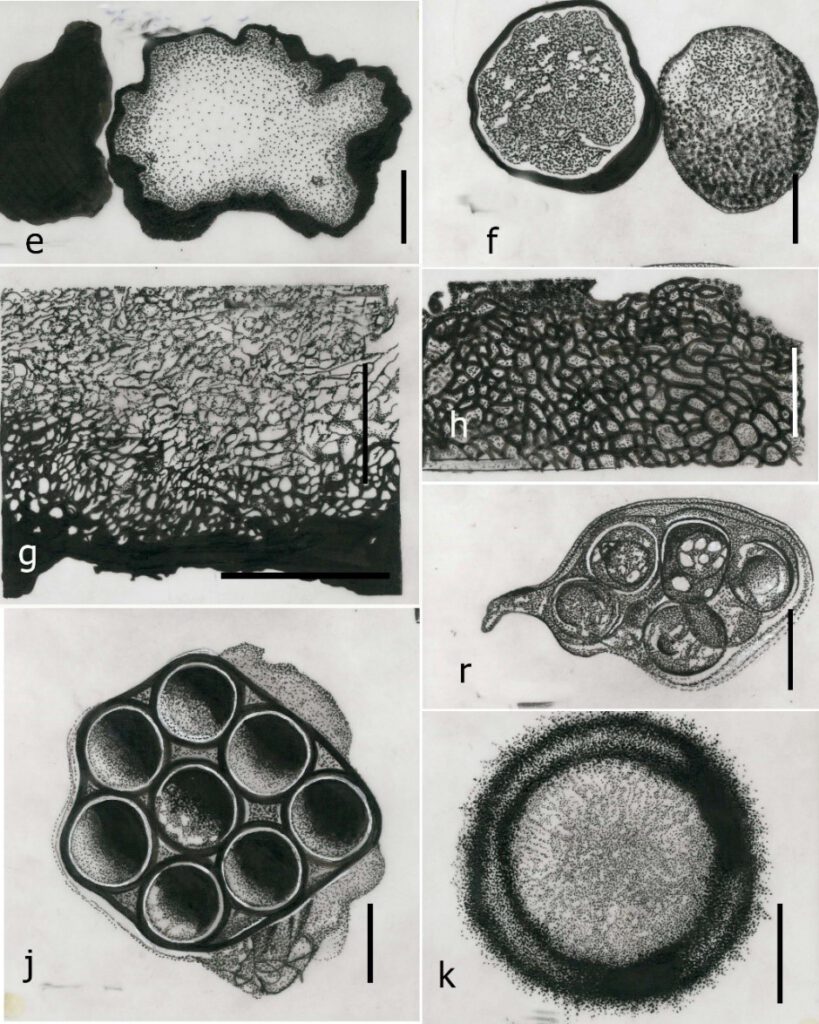Fungalpedia – Note 2 Imaia
Imaia Kovács &Trappe
Citation if using this entry: Noorabadi MT & Hyde KD (2023) New genera in 2008. Mycosphere (in press)
Index Fungorum Identifier 512081, Facesoffungi, MycoBank, GenBank, Figs 1, 2.
Imaia (Morchellaceae, Pezizales ) was introduced by Kovács et al.(2008) as a monotypic genus, to accommodate the type species Imaia gigantea (S. Imai) Kovács & Trappe (= Terfezia gigantea Imai). Imaia gigantea was originally collected from the soil of woodland in Japan, thus it is probably a saprobe. Phylogenetic analyses of SSU, ITS and LSU sequence data revealed that Terfezia. gigantea formed a clade distinct from other genera in Pezizaceae, and Terfezia gigantea was placed in Morchellaceae (Kovács et al. 2008). Based on morphological characters and phylogenetic analyses, Terfezia gigantea represented a new phylogenetic line and was sufficiently different from other taxa within Pezizaceae to introduce new genus Imaia (Kovács et al. 2008)
Fig 1. Ultrastructural characteristics of Imaia gigantea (redrawn from Kovács et al. 2008). a Ascospores with remnants of ascus. b Ascospore wall. c Woronin bodies. d Dome-shaped septal pore plug with V-shaped striations. Scale bars: a=20 μm, b =5μm, c=500 μm, d=1μm
Fig 2. Ascomata and microscopic morphology of Imaia gigantea (redrawn from (Kovács et al. 2008) e Dried slices of a large ascoma. f Mature ascomata with the structure of the gleba. g, h Cross-section of the peridium. r A young ascus with thick ascus wall and ascospores. j Matured ascospores within an ascus. k Mature ascospore with wall layer. Scale bars: e=3 cm, f =2 cm, g h=20 mm, r= 40 mm, j=40mm, k= 20mm.
Furthermore molecular phylogenetic information strongly supported that Imaia gigantea clustered with Leucangium carthusianum and the family Discinaceae as a sister group of Morchellaceae (Kovács et al. 2008). Imaia is characterized by spherical to roughly elliptical to irregular shaped fruiting bodies. Ascomata are globose to oval or irregular, brown, often cracked at maturity. The peridium comprises angular cells with thick walls. Gleba consists of brown pockets of asci that separated by white veins. Spores are globose to subglobose, with a thick, amorphous epispore, and this genus is distinct from Terfezia species with thick-walled peridial cells, large spores, and spore ornamentation resembling small spines covered with mucilage, that are unique in the genus. In addition, all the other species of Terfezia occur in dry habitats with mild winters, whiles Imaia gigantea is found in wet forests with cold winters (Kovács et al. 2008).
Type species: Imaia gigantea (S. Imai) Trappe & Kovács
Reference
Kovács GM, Trappe JM, Alsheikh AM., Bóka K, Elliott TF. 2008. – Imaia, a new truffle genus to accommodate Terfezia gigantea. Mycologia 100(6), 930–939 . https://doi.org/10.3852/08-023
Entry by
Maryam Tavakol Noorabadi, Center of Excellence in Fungal Research, Mae Fah Luang University, Chiang Rai 57100, Thailand.
(Edited by Kevin D. Hyde)
Published online 21 April 2023

